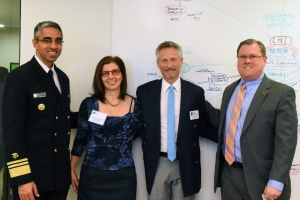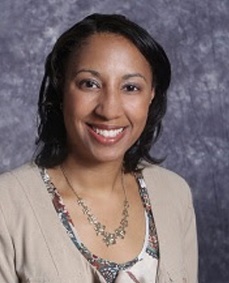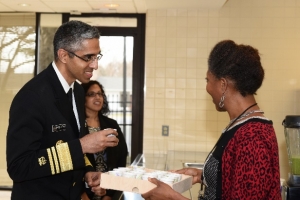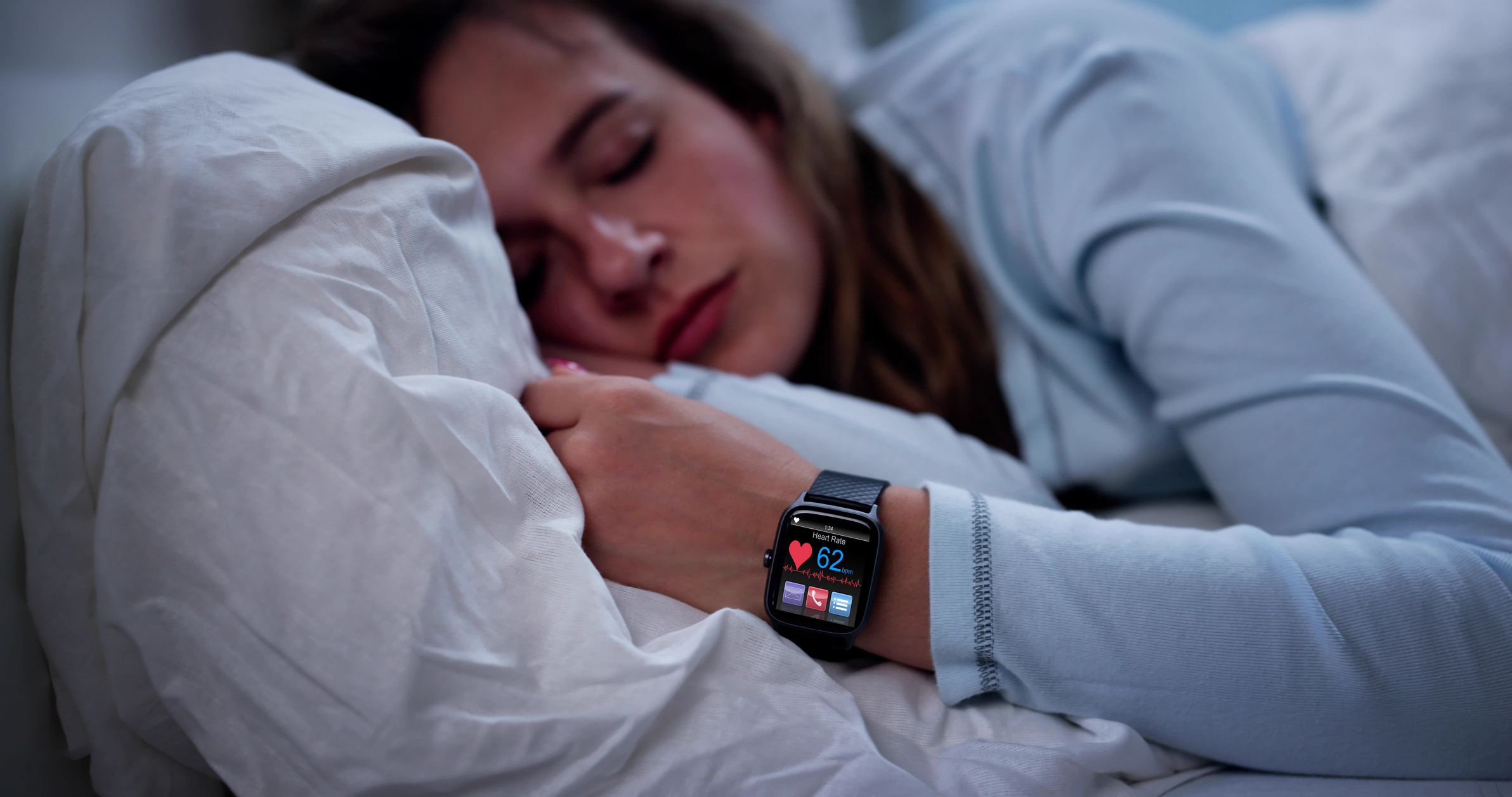Bending the cost curve: Casey Health Institute draws surgeon general visit
By John Weeks
 by John Weeks, Publisher/Editor of The Integrator Blog News and Reports
by John Weeks, Publisher/Editor of The Integrator Blog News and Reports
When philanthropist, Betty Casey, presented David Fogel, MD and Ilana Bar-Levav, MD with an opportunity to engage a significant integrative medicine venture, the two mind-body-oriented integrative physicians were determined to create a model that would become a national resource. Emerging data suggesting that the model is “bending the cost curve” and a visit last month by U.S. Surgeon General, Vice-Admiral Vivek Murthy, MD, MBA, suggests that the two are on the right path. (The photo shows the co-founders flanked by Murthy and Gaithersburg, Maryland Mayor Jud Ashman, during the visit.)
Casey offered significant financial support, plus a building not then in use. The two physicians set a plan to imbed their integrative initiative deeply in their community and in the nation’s emerging payment and delivery system. To be a national model, they reasoned, they had to serve members of the whole community, not just those who could pay cash. They needed to be in the insurance system and accept Medicare and Medicaid patients.
After looking at models nationwide, they chose to establish the Casey Health Institute (CHI) as a patient-centered medical home (PCMH). The multi-practitioner site opened its doors in February 2013 with zero patients. Last year, CHI cared for nearly 5000 patients via some 16,000 visits. CHI offered the care through an interprofessional team that includes integrative medical doctors, licensed acupuncturists, a naturopathic physician, a chiropractor, holistic nurses, yoga therapists, nutritionists, psychologists, massage therapists, a cooking center, group services, and more.
Murthy visited Casey Health Institute as part of his initiative to explore innovative healthcare practices that align with the National Prevention Strategy and focus on Emotional Well Being. Shares Fogel: “Patient and community engagement is a high priority for us. Our most recent patient satisfaction scores were above the national benchmark with 98.4% reporting that they would refer friends and family to CHI for their care.” A series of articles profiling CHI is here.
 Recent federal activity for CHI has an additional dimension. On March 1, 2017, CHI integrative medicine physician Kisha Davis, MD, pictured, was part of a select team of Maryland healthcare leaders who met with the Maryland’s Congressional delegation. Organized by US Senator Ben Cardin (D-MD), the panel was assembled to inform the state’s federal elected officials of the impact to Marylanders should the ACA be repealed.
Recent federal activity for CHI has an additional dimension. On March 1, 2017, CHI integrative medicine physician Kisha Davis, MD, pictured, was part of a select team of Maryland healthcare leaders who met with the Maryland’s Congressional delegation. Organized by US Senator Ben Cardin (D-MD), the panel was assembled to inform the state’s federal elected officials of the impact to Marylanders should the ACA be repealed.
As Fogel shared in an interview for this article, his vision of CHI expands outward from collaborative teams in clinical care, to onsite educational and health promotion efforts, to strategic impact in community health creation. Fogel envisions the area becoming a “Blue Zone” with CHI a hub. He has begun meeting with leaders of the local Chamber of Commerce and the municipality of Gaithersburg to talk up the idea. Gaithersburg Mayor Jud Ashman was at the Institute for Murthy’s visit.
Outcomes are bending the cost curve
The Casey Health Institute’s core work presently is in offering and making the case for the outcomes of the clinical services to the 5,000 patients that are currently users of CHI services. Some recent data follow:
- Demographics: 70 percent female; 66 percent white/13 percent Black/African American/5 percent Asian; 62 percent 35-64 years old, with 22 percent age 20-34 and 13 percent over 65.
- Chief diagnoses: pain (40 percent), anxiety/hypertension (17 percent), diabetes related (15 percent), hyperlipidemia (12 percent) and hypertension (11 percent).
 CHI’s operation as a Blue Cross Blue Shield CareFirst-recognized PCMH and as part of an Accountable Care Organization allows significant collection of cost-related data, and comparison with CHI’s peers. Fogel reports that “population health data from Medicare—13 percent of the practice—and via CareFirst PCMH—roughly 50 percent— indicate our model is bending the cost curve.” Here are a few recent highlights:
CHI’s operation as a Blue Cross Blue Shield CareFirst-recognized PCMH and as part of an Accountable Care Organization allows significant collection of cost-related data, and comparison with CHI’s peers. Fogel reports that “population health data from Medicare—13 percent of the practice—and via CareFirst PCMH—roughly 50 percent— indicate our model is bending the cost curve.” Here are a few recent highlights:
- Hospital Stayed Per 1000: Outperforming CMS targets, 5thbest PCMH in CHI’s ACO, with 19% fewer admissions than PCMH peer practices.
- 30-Day Readmission Rates: Outperforming CMS targets: 1stin ACO; and 19% fewer than PCMH peer practices.
- Pharmaceutical Costs: CHI patients’ pharmacy costs per member per month (PMPM) are 29% less as compared to PCMH peer practices (CHI $51.13 PMPM/PCMH peers $72.11 PMPM).
- Emergency Room Visits: CHI patients visit the ER 14% fewer times compared with PCMH peers (CHI 188/PCMH Peers 217.5).
Comment: As a person who believes that the context of accountable care and medical homes offers an alignment with integrative health and medicine principles and practices, I was among those who urged Fogel and Bar-Levav in this direction. I have closely followed the Casey Health Institute experience from the beginning. See the set of articles below. Here’s hoping that Surgeon General Murthy and Blue Cross/Blue Shield will each decide that this cost-saving and innovative, integrative PCMH model is worthy of further examination, additional support and proliferation elsewhere.
The links below are to a four-part profile on Casey Health Institute’s model developed through a partnership between the Integrator Blog News and Reports and the Academic Collaborative for Integrative Health through its Project for Integrative Health and the Triple Aim.
- Casey Health Institute: Marrying Integrative Health and Values-Based Medicine (June 2015)
- Speed-Dating: A Casey Health Institute Method for Building a High Performing Interprofessional, Integrative Team (September 2015)
- Cory Jecmen, MAc, LAc: An Acupuncturist/Tech Player in Casey Health Institute’s Integrative PCMH (October 2015)
- Casey Health Institute: EVP/COO Tracey Gersh, PhD on Bridging Integrative Health into a PCMH and Accountable Care (November 2015)
















